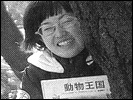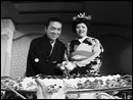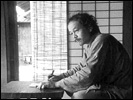 |
 |
|
Jishu Eiga special
Reviews by Tom Mes [TM] and Jasper Sharp [JS]
Jishu Eiga is the name for Japan's ever-increasing phenomenon of self-made films. Made mostly on DV by students and film fans, these no-budgets films range from five-minute exercises to entire features. Many of them take a very personal perspective, like Satoshi Ono's Homemade Sake, but the range of styles and genres on offer is quite astounding. This issue of Round-Up we have a look at some of these jishu eiga, which show a good amount of promise and in some cases have already resulted in professional filmmaking careers for their directors.
Annyong Kimchee
Dandelion
Every Japanese Woman Makes Her Own Curry
The Gaze
Hatsukoi - Love, a First
How I Survive in Kawaguchi City
Machibito
|
 |
Annyong Kimchee
Original Title: Annyon Kimuchi
Director: Tetsuaki MATSUE
Running time: 52 mins.
Year: 1999
 Japan and Korea have had a troubled relationship over the centuries, and discrimination against Korean residents in Japan is legendary. But how important is the issue of race to a younger generation born and raised in the country. Tetsuaki Matsue, a third-generation zainichi attempts to get to grips with the issue of his own national identity in this autobiographical video documentary made several years ago as the then 21-year-old director's graduation project from the Japan Academy of the Moving Image. Japan and Korea have had a troubled relationship over the centuries, and discrimination against Korean residents in Japan is legendary. But how important is the issue of race to a younger generation born and raised in the country. Tetsuaki Matsue, a third-generation zainichi attempts to get to grips with the issue of his own national identity in this autobiographical video documentary made several years ago as the then 21-year-old director's graduation project from the Japan Academy of the Moving Image.
Anyonng Kimchee begins with Matsue confessing to a group of assembled friends "I'm not really Japanese, I'm Korean" before an evening session in a Karaoke box. To his surprise, none of them seem particularly fazed or concerned by the revelation. To Matsue, however, this newly awakened awareness of his roots seems to be causing some degree of angst. The fruits of a Korean bloodline, yet unable to speak the language of his ancestors due to having been raised in the country of the "chokpari" (a derogatory term Koreans use for the Japanese), any feeling of latent Korean-ness is further tempered by an innate revulsion for that spicy staple of the Korean diet, kimchee.
After a brief backtrack through history detailing the Japanese colonisation of Korea from 1910 to 1945 where Koreans were forced to assume Japanese names and work in Japan, for the bulk of the film he adopts the format of an intimate family portrait as the assorted clan of parents, aunts, uncles and grandmother are interviewed about the first family member to come over to Japan, Tetsuaki's now deceased grandfather Yukichi Matsue (born Yu Chon-Sik). It is clear from this personal history that times have changed a great deal in the decades following Yukichi's arrival not speaking a word of the language. As he strove to completely assimilate into Japanese society, amazingly he soon managed to successfully pass himself off as more Japanese than most Japanese, and a valuable pillar of the local community. Yet to his dying day, he was forced to carry the alien registration card.
After the young Tetsuaki returns from a trip to the village of his grandfather's birth in Korea, camera in hand, his various family members are quizzed as to which country they feel they most belong. Sister Masako, who narrates the bulk of the piece, is in no doubt about where she feels most comfortable, as she addresses the camera clutching a large fluffy Hello Kitty stuffed toy. Other members of the family don't seem quite so sure. A highly likeable and elucidating look at an issue about which clearly a lot more needs to be known.
[JS]
|
 |
Dandelion
Original Title: Tanpopo No Saigetsu
Director: Shujian REN
Running time: 60 mins.
Year: 2003
 One of the characteristics of Japanese cinema of the late 90s has been an increasing interest in the country's ethnic minorities. From Yoichi Sai's 1993 film All Under the Moon via Takashi Miike's Black Society trilogy to Isao Yukisada's GO, Japan's Korean and Chinese communities in particular have stepped into the spotlight and become regular fixtures of the cinematic landscape. One of the characteristics of Japanese cinema of the late 90s has been an increasing interest in the country's ethnic minorities. From Yoichi Sai's 1993 film All Under the Moon via Takashi Miike's Black Society trilogy to Isao Yukisada's GO, Japan's Korean and Chinese communities in particular have stepped into the spotlight and become regular fixtures of the cinematic landscape.
That their position might not be as rosy in daily life is something suggested by the documentary Dandelion. It follows an extended family of illegal immigrants from Fujian, China, who have come to Tokyo to find jobs that will allow them to support their relatives back home. Working in the margins of society, mostly in jobs that cater to the city's Chinese community, many of them work around the clock in order to not only send home enough money, but above all to pay off their debts to the people smugglers who got them into the country. At the same time they are constantly on their guard for immigration officers.
Directed by Shujian Ren, himself a Chinese born in Nanking, Dandelion is a brutally honest look at the tribulations lived by these economic immigrants. The film is harrowing at times, mostly because the viewer comes to realise that even though the protagonists break the law, they do so with the earnest intention of providing for their families. One young man has a wife and child in China, but has no other choice but to marry a Japanese woman to make his stay a legitimate one so that he can continue to provide for his family back home. The woman who offered to help him out regularly abuses her new husband's vulnerable position and even runs off with this savings at one point.
Much like Michael Winterbottom's superb In This World, which detailed the hardships lived by Afghan refugees that attempt to reach the promised land of Britain, Dandelion makes you realise that there is more to the issue of refugees and immigrants than a supposed attempt to profit from another person's riches. The phantom image of immigrants stealing native jobs is decisively debunked in Dandelion, given that the film's protagonists all work jobs that cater to other Chinese immigrants, jobs that no Japanese would be able to do in the first place.
[TM]
|
 |
Every Japanese Woman Makes Her Own Curry
Original Title: Karee Raisu No Onnatachi
Director: Tetsuaki MATSUE
Running time: 30 mins.
Year: 2003
 After Summer Vacation with Naomi Kawase, a "making-of" document of Kawase's last film, Shara, Matsue was one of a number of young filmmakers approached by Kunihiko Tomioka of the Planet Studyo +1 cinema in Osaka as part of the Eyes of Cineastes series. Their remit was to go out and "film documentaries of themselves and their surroundings". After Summer Vacation with Naomi Kawase, a "making-of" document of Kawase's last film, Shara, Matsue was one of a number of young filmmakers approached by Kunihiko Tomioka of the Planet Studyo +1 cinema in Osaka as part of the Eyes of Cineastes series. Their remit was to go out and "film documentaries of themselves and their surroundings".
Billing itself as "3 nights and 4 days with curry and women in Tokyo", Matsue's piece was prompted when construction work next-door forced him from his apartment for a couple of days and in need of somewhere to stay. He hit upon the ingenious idea of phoning several young female acquaintances and inviting himself round to film them cook dinner for him. The one proviso is that each cooks curry rice, which, since it was the only dish that his first girlfriend could muster, is Matsue's favourite dish.
Matsue's subjects are Eri, (age 27), a pink actress who appeared in Takahisa Zeze's Tokyo X Erotica and who introduces Matsue to the cosmopolitan delights of the zucchini; Kayako (27), who forgets to put the carrots in her one; and finally his current sweetheart Mika (29), whose attempt at pepping up the project with a Thai green curry mix bought from Muji prove too hot for the man whose tastes in curry are like his films - mild and sweet.
Matsue has said that his twin interests in movies are documentary and hardcore Adult Video. The similarities between the two genres - the recording of real, non-simulated action with the rawness of the production a testament to its vérité nature - have been picked up on by critics numerous times before. One further documentary-inspired peculiarity of Japanese AV films is the lengthy interviews that usually precede the sex sequences, and Matsue has mentioned that he structured this film along similar lines. The girls are introduced then sent to the kitchen to perform, responding to Matsue's inane chatter off-screen behind the camera. After his appetite is satisfied, the two wind down with a few minutes of after-meal banter (pilau talk?) as they digest their meal.
Still, a documentary is more than a mere record of events or footage of people talking directly to the camera - there needs to be some sense of purpose about it. The results here are certainly watchable enough by the standards of the numerous cooking shows that fill the nation's TV channels. But unlike the fascinating Annyong Kimchee there's a distinct "so what?" air about this piece, and the end impression is of someone worming his way into various ladies' apartments and getting them to cook for him, then presenting his on-camera conquests to the rest of the world.
With his most recent work, Identity (2004), Matsue has managed to combine all his interests into a two-hour documentary about zainichi Korean girls who work in the sex video industry. The film, having been produced for AV market, features numerous lengthy hardcore sex scenes.
[JS]
|
 |
The Gaze
Original Title: Shisen
Director: Yosuke YAMAMOTO
Running time: 5 mins.
Year: 2004
Frankfurt's Nippon Connection festival has been steadily growing into a force to be reckoned with when it comes to spreading the word about Japanese cinema and culture in Europe. Now in its sixth year, it has expanded its activities well and truly beyond the simple screening of films and is actively supporting production by young and student filmmakers.
After releasing a compilation CD of music using samples of sound recorded in the Tokyo subway system, the festival set up the Exchanging Tracks project, in which a group of students from Kawasaki's Japan Academy of Visual Arts were asked to make short films inspired by the tracks on the album.
The fruits of this collaboration were shown at the 2004 edition of Nippon Connection, and one of the most interesting ones was Yosuke Yamamoto's The Gaze. Yamamoto's five-minute film is a visual variation on the method of sampling, but one that has quite an intriguing effect. Yamamoto took his DV camera into the subway and mimicked the behaviour of a stalker, choosing people from the crowd and following them for a while to see where they went and what they did.
The effect is one reminiscent of Edgar Allan Poe's short story The Man of the Crowd, which took as its premise the thought that all of us have had has when walking through a busy city street: "Who are these people, where are they going and for what purpose?" By fixing his gaze on a single person among many, Yamamoto pulls out that person and individualises him or her. The result is that the subject is no longer simply a component of the surroundings, but he or she becomes an individual human being.
This is emphasised by the fact that many of the people the director's gaze falls upon are visibly aware of his presence. They show signs of discomfort at being followed by someone with a camera. What is normally an unwanted side effect for documentary filmmakers - the presence of the camera influencing what is being recorded - in Yamamoto's film actually underscores the success of his approach. This astute awareness shows great promise in the young filmmaker.
[TM]
|
 |
Hatsukoi - Love, a First
Original Title: Hatsukoi
Directors: Daisuke MIURA, Makiko MIZOGUCHI
Cast: Daisuke MIURA, Makiko MIZOGUCHI
Running time: 98 mins.
Year: 2003
 Home-made features are still a rarity. That they are as refreshing and endearing as Hatsukoi is even rarer. A love story between ugly people, it is the antidote to the idol movie, which is gaining an ever greater foothold on commercial filmmaking in Japan. In Hatsukoi, nobody wears make-up, everyone is more than slightly odd, and fashion is non-existent. Rarely in recent years has a love story been more realistic and resonant. Home-made features are still a rarity. That they are as refreshing and endearing as Hatsukoi is even rarer. A love story between ugly people, it is the antidote to the idol movie, which is gaining an ever greater foothold on commercial filmmaking in Japan. In Hatsukoi, nobody wears make-up, everyone is more than slightly odd, and fashion is non-existent. Rarely in recent years has a love story been more realistic and resonant.
Dim-witted Misako delivers newspapers and works with colleagues even more dim-witted than she is. When she loses her pile of papers, she agrees to sell subscriptions door-to-door for free as a penalty. After having the door slammed in her face an uncountable number of times, she finally has a catch in Yoshida, an unshaven, lanky, solitary man given to spontaneous erections at the most inopportune moments when in her company. The two start a tentative relationship that is hardly the dictionary definition of romance, but in which their mutual lack of social skills seem oddly complementary.
Rather than plotted, Hatsukoi's depiction of a love relationship evolves in almost natural fashion. Although we laugh at first at the homely characters, the film's earnesty quickly becomes resonant and subsequently irresistible. Despite not starring a single beautiful person, Hatsukoi is as endearing a romantic tragicomedy as one could possibly hope for.
[TM]
|
 |
How I Survive in Kawaguchi City
Original Title: Kawaguchi De Ikiroyo!
Director: Kenji MURAKAMI
Running time: 30 mins.
Year: 2003
 Revealed to the world with the memorable Tel-Club (Natsu Ni Umareru) back in 1999, Kenji Murakami is one of the leading lights of Japan's jishu eiga scene. Armed with a DV camera wherever he goes, like the bastard son of Shohei Imamura and Woody Allen he makes films that blur the lines between fiction and documentary in a playful, self-deprecating way that, despite its seeming lightweight nature, skilfully challenges the viewer's preconceptions about reality and fiction in cinema. Revealed to the world with the memorable Tel-Club (Natsu Ni Umareru) back in 1999, Kenji Murakami is one of the leading lights of Japan's jishu eiga scene. Armed with a DV camera wherever he goes, like the bastard son of Shohei Imamura and Woody Allen he makes films that blur the lines between fiction and documentary in a playful, self-deprecating way that, despite its seeming lightweight nature, skilfully challenges the viewer's preconceptions about reality and fiction in cinema.
How I Survive in Kawaguchi City is an account of how lower rents drove him to settle in a dull suburb of Tokyo. Initially taking his surroundings for granted, his decision to compete in the local marathon race on the behest of his wife changes his perspective. Running around town on his daily practice rounds, he discovers the various nooks and crannies of Kawaguchi and learns that there is more than meets the tired commuter's eye.
Another entry in Kunihiko Tomioka's Eyes of Cineastes series, How I Survive in Kawaguchi City is an irresistibly humorous declaration of love to suburban life, made with an awareness of the medium that is so characteristic for its director Kenji Murakami. The director has since gone on to direct commercial features, but he continues to make his particular brand of jishu eiga.
[TM]
|
 |
Machibito
Original Title: Machibito
Director: Jun WATANABE
Cast: Ikuro YAGI, Yumi KAWASHIMA, Ryo KUROSAWA
Running time: 13 mins.
Year: 2003
 The use of digital video as medium of choice for independent filmmakers has become almost incontestable, to the point of being self-evident. The acceptance of the medium as a standard in both recording and exhibiting, thanks in no small amount to the efforts of Lars von Trier and his Dogma cohorts, has greatly contributed to this situation: anyone making films on DV knows that the material won't be a hurdle towards getting their film shown. In fact, we've almost come to expect independent films and student films to be made on DV. It has become the standard and 8mm or 16mm are now the exception. The use of digital video as medium of choice for independent filmmakers has become almost incontestable, to the point of being self-evident. The acceptance of the medium as a standard in both recording and exhibiting, thanks in no small amount to the efforts of Lars von Trier and his Dogma cohorts, has greatly contributed to this situation: anyone making films on DV knows that the material won't be a hurdle towards getting their film shown. In fact, we've almost come to expect independent films and student films to be made on DV. It has become the standard and 8mm or 16mm are now the exception.
Jun Watanabe, film student from Kawasaki, is one of those exceptions. A cinephile in the classic sense of the word, he counts Bresson, Dreyer and Tarkovski among his influences, and his first film Machibito shows how unusual that kind of sensibility has become among young filmmakers.
Based on a story by author Soseki Natsume - another more classical influence - and made on 8mm in sepia-toned black and white, its elegant, subdued style harkens back to different times and is a vast contrast with the jumpy, scattered style of most indie DV filmmakers of his generation. And where those DV filmmakers increasingly stay close to home, Watanabe dares to be fictional, both in terms of story and style. That this move would seem so bold makes one realise how dangerously close to monotony the current crop of DV filmmakers sometimes veer.
[TM] |